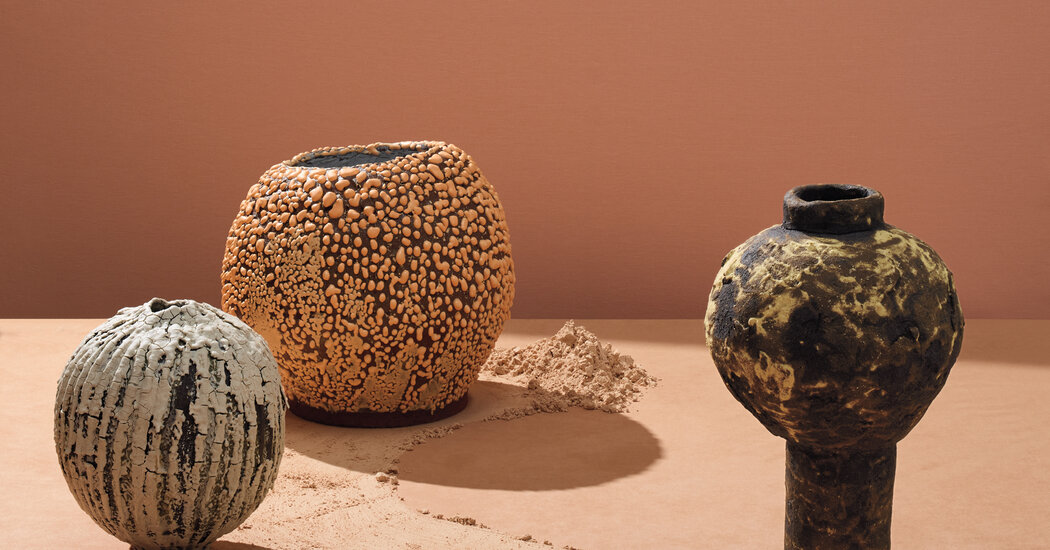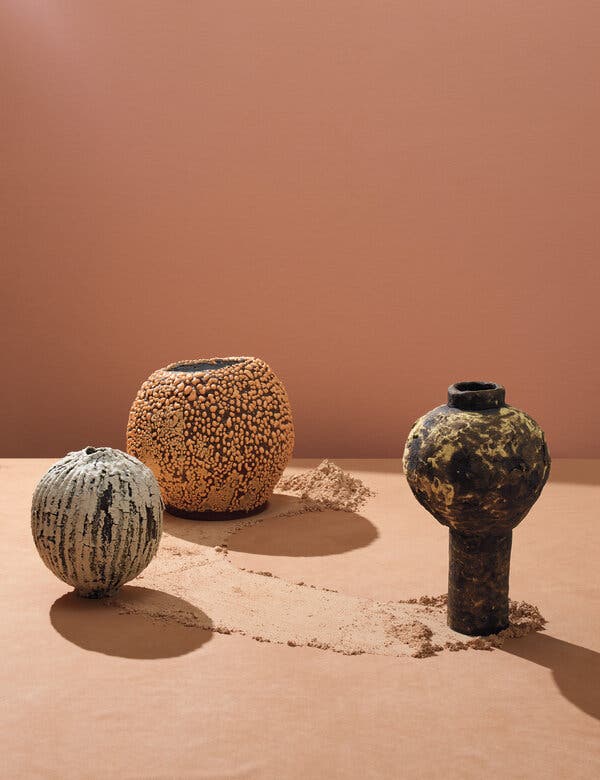
THE TRADITIONAL KOREAN moon jar — a large, rounded vessel glazed with an opaline sheen — has been a much-celebrated object for centuries. Historically made from baekja, a porcelain of refined white kaolin clay, moon jars rose to prominence in the late 17th century, a time when the country’s neo-Confucian ideals inspired an aesthetic preference for austerity, clarity and understated elegance. The pale, simple orbs — made from two wheel-spun halves joined together, the seam between them smoothed to a faint yet indelible meridian — represent a balance between technical ingenuity and chance. As important are the irregularities, which speak to the piece’s handmade quality: an errant scattering of ash or debris, for example, or a subtle tinge of light blue, brown or rust.
The jars, which were originally used for storage and floral arrangements and made by anonymous potters of the late Joseon-era royal court, were a lifelong object of fascination for the seminal Korean abstract artist Whanki Kim (1913-74), who saw in their minimal form the essence of his culture’s artistic philosophy, and who popularized their name, dal hangari (“moon jar”), in the mid-20th century. (More recently, the moon jar’s hemispherical halves have come to symbolize hope for reunification between North and South, particularly in the work of the Korean American artist Ik-Joong Kang.)
In modern Korea, ceramics masters like Young Sook Park and Dae-Sup Kwon are credited with reviving the craft and revered for their dedication to a process that yields no more than 10 or so porcelain jars a year. RM, the lead rapper of the K-pop group BTS, is perhaps the most famous collector of Kwon’s work; in 2019, he posted a photo on Twitter of himself embracing a large and slightly off-center jar created by the artist.
THESE DAYS, THE form is finding new practitioners and admirers beyond the Korean Peninsula. “Porcelain holds memory,” the Brooklyn-based ceramist Jane Yang-D’Haene, 52, says of the unforgiving material. A former interior designer, she works instead with stoneware, brushing, dipping, scoring and layering her hand-built vessels with various glazes. Moon jars have also allowed Yang-D’Haene a way to honor her cultural roots as a first-generation Korean American. “I struggle with being perfect,” she says. “Moon jars remind me that imperfection is OK.”

Moon jars by, from left, the Brooklyn-based ceramist Jane Yang-D’Haene, Lee and the potter Ilona Golovina, also based in Brooklyn.
For the potter Clair Catillaz, 38, of the Catskill, N.Y.-based Clam Lab, moon jars represent the iconic form of an admirable ceramics tradition. In 2016, she visited London’s British Museum, home to the West’s most storied moon jar, made in 18th-century Korea by an unknown artisan, acquired by the British potter Bernard Leach in 1935 on a visit to that country during its occupation by Japan and gifted to his friend and fellow potter Lucie Rie in 1943. “It was imposing, and big,” Catillaz says of the piece. “Seeing it in real life, it’s like seeing a celebrity, almost.”
Earlier that summer, Catillaz had taken a workshop at Alfred University’s College of Ceramics with the master potter Kwangho Lee, who shared a range of traditional Korean techniques, including those for making wheel-spun moon jars, as well as slab-and-coil-constructed onggi, large-scale vessels used for fermentation. Watching him work, she learned about building vessels in “what I have come to understand is the Korean style,” she says, “this very loose, very confident touch that’s not so precious but very direct.” In her own practice, rounded clay bodies find slightly erotic biomorphic contours, with arms curled like horns or fiddlehead ferns, and geometric incised openings carved from smoothed exteriors. Catillaz adds squared pedestals and an array of subtly colored glazes that almost appear airbrushed to her moon jars, giving some of them a warm patinated effect and others a faintly sparkly, celestial shimmer.
For the self-taught potter Ilona Golovina, 35, a native of Stavropol, Russia, now based in Brooklyn, part of the moon jar’s appeal lies in its ability to communicate the terroir and culture of its maker. She often uses foraged clay, as well as refuse materials from quarries, mines and artists’ studios. She incorporates these into experimental slip glazes for her moon jars, some of which are crafted with elongated cylindrical bases and necks. “My works are more like a moon and less of a moon jar,” she says, “but it’s still a reference, and I make them with a respect for the culture and the tradition.”
Other artists have completely subverted the classic moon jar’s serene surface, transforming it into something altogether new. The 46-year-old Los Angeles-based artist and writer Raina Lee’s hand-built, free-form vessels feature cratered surfaces that resemble bubbling molten lava. Lee creates the volcanic effect by mixing her custom glazes with silicon carbide, which causes tiny explosions in the kiln. While that kind of pinholing is normally considered bad technique, “I feel like it’s a distinct language for me,” says Lee, who intentionally blends and applies the glaze as thickly as pancake batter so that the pocks grow and overlap, creating an extreme, exaggerated effect. “A lot of people want control and to achieve different kinds of glaze perfection,” she says. “I realized that’s just not a constraint I want to work with. So I went the other direction, embracing the chaos.”
In addition to the Korean moon jar, Lee finds inspiration in a wide range of traditional ceramic forms, from China, Iran, Japan and Greece, which she’ll often glaze in unexpected, high-contrast palettes of bright neons, subdued pastels and earthy hues. At the same time, she takes comfort in the age-old wisdom of pottery techniques, which — like the moon jar itself — haven’t fundamentally changed over the centuries. “I’m interested in being part of that legacy,” she says, “and drawing upon it.”
Set design by Victoria Petro-Conroy. Photo assistant: Serena Nappa. Set assistant: Constance Faulk